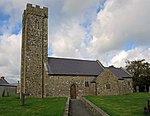Johnston railway station
DfT Category F2 stationsFormer Great Western Railway stationsRailway request stops in Great BritainRailway stations in Great Britain opened in 1856Railway stations in Pembrokeshire ... and 2 more
Railway stations served by Transport for Wales RailUse British English from March 2013

Johnston railway station is an unstaffed railway station in the village of Johnston in Pembrokeshire, Wales. It opened in 1856 as part of the final section of the South Wales Railway main line from Haverfordwest to Neyland. It has gone by various names and is now operated by Transport for Wales Rail. Train stops are made at the station by request only. The station was the junction for trains to Neyland and also the branch line to Milford Haven. Johnston is the penultimate stop on the West Wales Line before Milford Haven.
Excerpt from the Wikipedia article Johnston railway station (License: CC BY-SA 3.0, Authors, Images).Johnston railway station
St. Peter's Road,
Geographical coordinates (GPS) Address Nearby Places Show on map
Geographical coordinates (GPS)
| Latitude | Longitude |
|---|---|
| N 51.757 ° | E -4.996 ° |
Address
St. Peter's Road
St. Peter's Road
SA62 3PZ , Johnston
Wales, United Kingdom
Open on Google Maps







